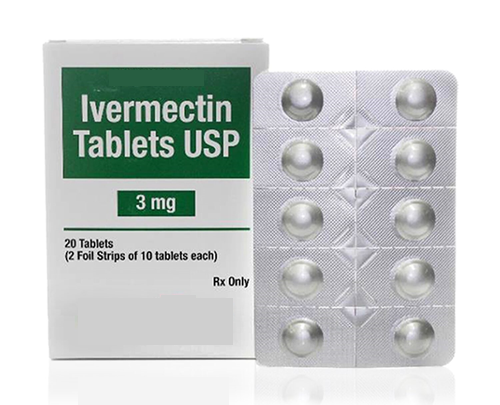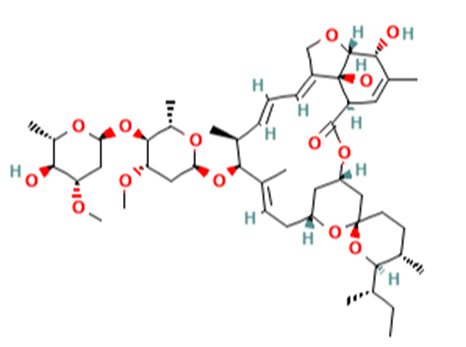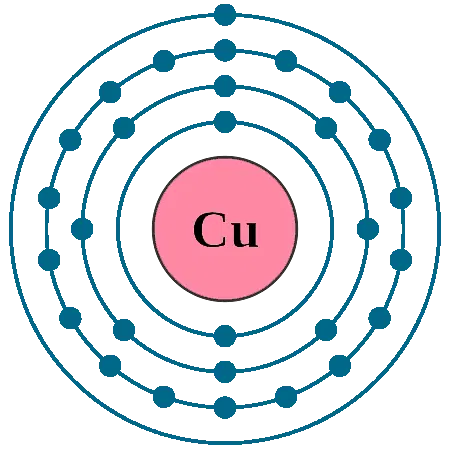What are the functions of Ivermectin?
Description
Ivermectin is one of the most important antibiotics discovered. It is recognized as a landmark drug by the American Chemical Society, and its discoverers received the Nobel Prize in 2015. Additionally, ivermectin is one of the most widely used anti-parasitic drugs for animals and humans.
Uses
Since 1987, about 3·7 billion treatments have been given worldwide, primarily for mass drug administration (MDA) campaigns for onchocerciasis and lymphatic filariasis in sub-Saharan Africa[1]. Ivermectin is also highly effective against Strongyloides, scabies, and ticks, and it has recently been shown to be an effective endectocide that kills feeding mosquitoes with the potential to reduce malaria transmission. The use of ivermectin will expand. For example, findings showed that ivermectin combined with diethylcarbamazine and albendazole is more effective than diethylcarbamazine plus albendazole as part of an MDA campaign for the treatment of lymphatic filariasis, resulting in the greatly expanded use of ivermectin in MDA programmes worldwide.
Ivermectin is a mixture of more than 80% 22,23-dihydroavermectin B1a and B1b. It is a remarkably potent anthelmintic and insecticide when given orally at therapeutic doses of 150 or 200 μg/kg to ruminants, pigs, horses, or humans, where it yields Cmax plasma concentrations of 11–54 ng/ml or 13–63 nM. It is generally safe, with acute LD50 toxicities seen at 24 000 μg/kg in monkeys and 80 000 μg/kg in beagles; it has a wide spectrum of action against gastrointestinal (GI) parasitic nematodes, lungworms, lice, and mange, but it is not effective against cestodes or trematodes. However, it is very effective against microfilaria at low plasma concentrations and impairs adult filaria fertility for long periods without killing most adult filaria.
Mode of Action
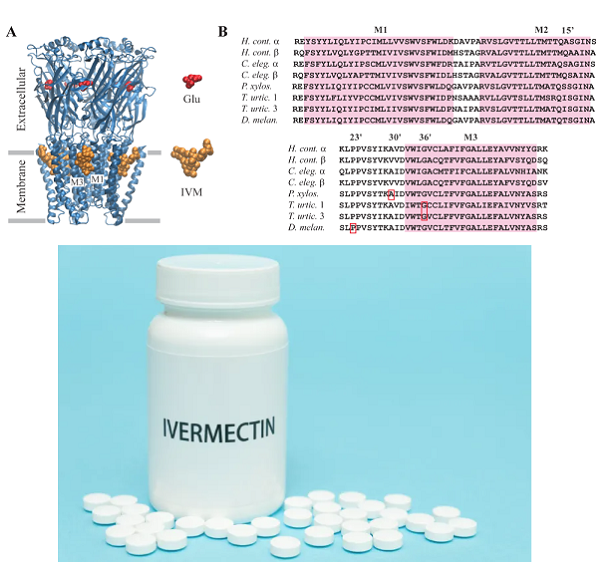
As a highly effective, broad-spectrum anthelminthic drug that targets GluClRs, Its binding site is formed between the first (M1) and third (M3) transmembrane domains contributed by adjacent subunits, as shown above[2]. The drug is used extensively as an insecticide and anti-parasitic agent, where its mechanisms of action include paralysis of feeding structures, such as the pharynx, in adult organisms and impairment of larval viability. Ivermectin and its analogs are positive allosteric modulators (PAMs) that selectively open inhibitory glutamate-gated chloride ion channels in the membranes of pharyngeal muscles, motor nerves, female reproductive tracts, and the excretory/secretory (ES) pores of nematodes and of muscle and nerves of insects and crustaceans[3]. The effect is (i) inhibition of pharyngeal pumping when the pharyngeal muscle is the target; (ii) inhibition of motility when motor nerves are the main target; (iii) inhibition of egg or microfilaria release when the female reproductive tract is the target site; and (iv) loss of host immunosuppression when the ES pore cannot open to release host immunosuppressants.
References
[1] King, Christopher L. “Is ivermectin safe in pregnancy?” Lancet Global Health (2020): e12–e13.
[2] Mohammed Atif. “GluClR-mediated inhibitory postsynaptic currents reveal targets for ivermectin and potential mechanisms of ivermectin resistance.” PLoS Pathogens 15 1 (2019): e1007570.
[3] Richard J Martin, Shivani Choudhary, Alan P Robertson. “Ivermectin: An Anthelmintic, an Insecticide, and Much More.” Trends in parasitology 37 1 (2021): 48–64.
You may like
Related articles And Qustion
See also
Lastest Price from Ivermectin manufacturers
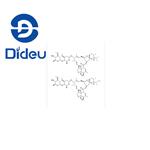
US $0.00/kg2025-11-11
- CAS:
- 70288-86-7
- Min. Order:
- 1kg
- Purity:
- 99%
- Supply Ability:
- 10000KGS

US $0.00/box2025-09-26
- CAS:
- 70288-86-7
- Min. Order:
- 1box
- Purity:
- 0.99
- Supply Ability:
- 10tons

